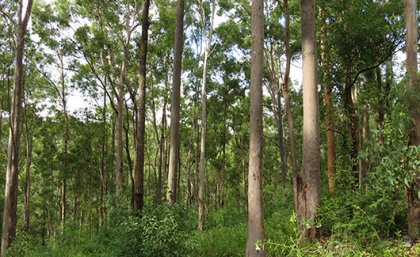
Research conducted by The University of Queensland has revealed that Queensland native forestry, including timber harvesting, could actually help conserve biodiversity and mitigate climate risks.
Dr Tyron Venn from UQ’s School of Agriculture and Food Sustainability reviewed more than 350 publications, studying the ecological and economic impacts of Queensland native forest management, which includes everything from fire management to timber harvesting.
“Stopping forestry in Queensland’s native forests may sound like a positive outcome for the environment, but the research suggests that it would further shift our impacts offshore and increase carbon emissions, while generating little benefit for biodiversity conservation within Australia,” Dr Venn said.
Since the 1990s, Australia’s annual harvest of native hardwood sawlogs has dropped by 2.2 million cubic metres, as large areas of state-owned native forests have been declared National Parks or other types of conservation reserves in which harvesting is not allowed.
“Over the same time period, imports of hardwood products from less-well managed forests in Asia and the Pacific increased by a similar amount,” Dr Venn said.
“In many developing countries, large international timber companies operate with disregard for the environment and often have negative impacts on traditional forest communities.”
“Without realising it, many Australians buy products made with foreign timbers and threaten conservation efforts for the orangutan, Malayan tiger, Asian sun bear and Asian tapir.
The research found that Queensland’s low-intensity forestry management techniques are informed by science to minimise environmental impacts.
Queensland law allows selection harvesting in some of the state’s public and private native forests, which typically removes 10 to 20 trees per hectare every 20 to 40 years.
Strict rules regulate how this is conducted, such as by requiring minimum retention of trees of different sizes, including large old trees with hollows.
“Selection harvesting can restore wildlife habitat, promote and conserve floristic diversity and improve the resilience of large trees against climate change and bushfire,” Dr Venn said.
Dr Venn said forestry is the twenty-fifth most important threat to biodiversity in Australia, and forestry in Queensland impacts only 0.8 per cent of Australia’s 1,795 threatened species.
“There are 24 more important threats we should be focused on, including invasive weeds, invasive predators, urban development, and reduced fire frequency or intensity” he said.
Dr Venn said Queensland should continue to manage some of its forests for wood production, as recommended by the Intergovernmental Panel on Climate Change (IPCC).
“The IPCC has long argued that sustainably managing forests to produce timber, fibre and energy will generate the largest carbon sequestration benefit from forests,” he said.
“If Queensland reduced its native forestry in the near future, the knock-on effect would be negative impacts on global efforts to conserve biodiversity and reduce carbon emissions due to increased consumption of timber imports and carbon polluting substitutes.
“Queensland can maximise its contribution to global biodiversity and climate goals by continuing to manage some of the state’s native forests for timber production.”
The research has been published in Forest Policy and Economics.
Media: Dr Tyron Venn, t.venn1@uq.edu.au, +61 (0)499 384 852; Faculty of Science Media, science.media@uq.edu.au, +61 (0)438 162 687.
.jpg)










